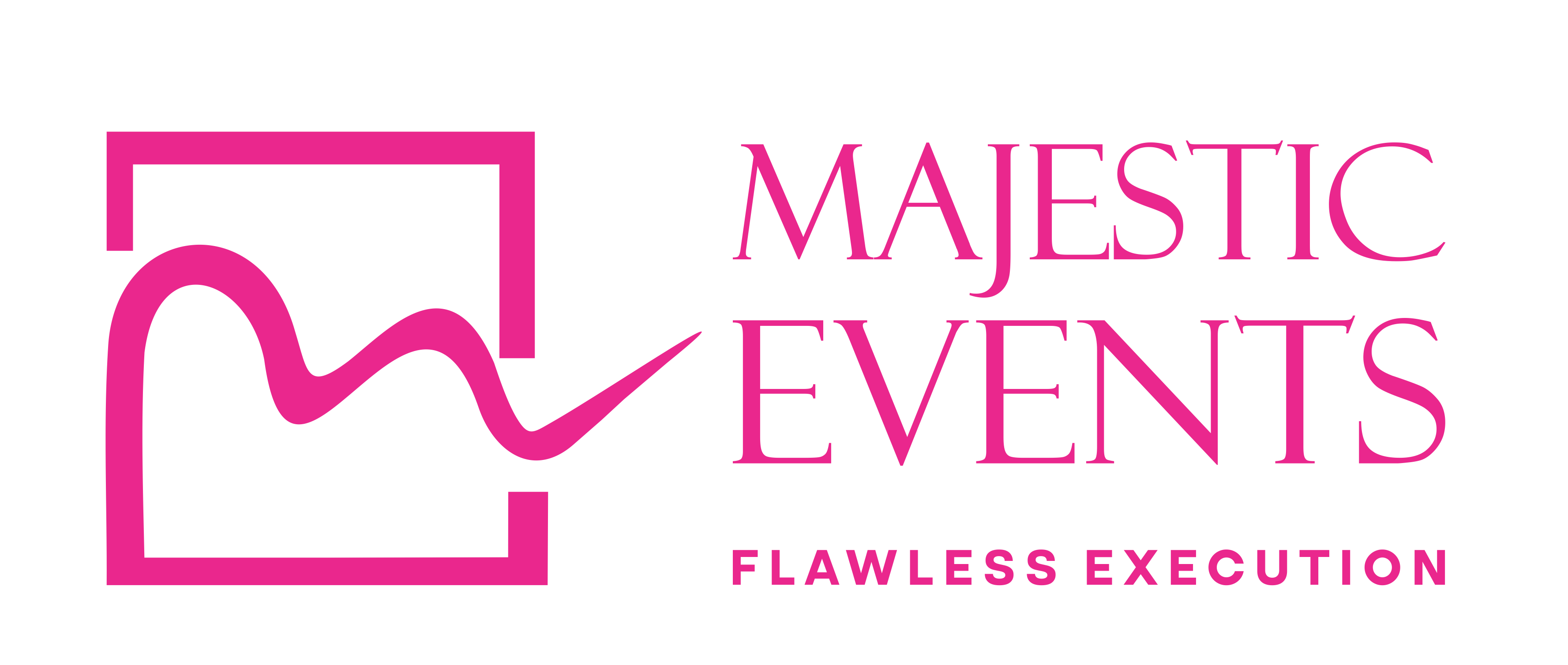In Events Marketing, captivating your audience through strategic gatherings is critical—whether by hosting, engaging in, or attending events. Among the most impactful tactics in Majestic’s Events Marketing arsenal is Product Launches. These high-energy showcases not only unveil new offerings but also set the stage for a memorable brand experience, turning every launch into a must-attend occasion.
What Is A Product Launch?
A Product Launch involves various marketing activities to unveil a new product or service. This can encompass anything from physical gadgets and products to software and other intangible services. A Product Launch aims to generate buzz, build relationships with your audience, showcase features, drive sales, and establish credibility within the market.
Planning any event demands meticulous attention to detail. Majestic Events just recently had a Product Launch event. Here are some lessons they learned and some tips they could share with you:
Pre-Event Tips
Tip #1 – Type of Product Launch: Consider the nature of the product being launched, the target audience, and the event objectives. What does your client want?
Product launches can vary widely. Imagine organizing a book launch for a politician, a well-known business tycoon or an Engineer but planning it as a wedding with flowers and extravagant decorations. I don’t think anyone will attend this event for a long time.
Tip #2 – Vist! Vist! Visit!: Go all out for your clients. Put yourself in their shoes. What would they like to see and experience at a product launch event?
It might be the perfect hotel, garden, or conference room—do not settle for the first venue you see. Before finalizing the venue, conduct site visits to multiple places. Pay attention to details such as the outward appearance—road condition, entrance aesthetics, welcoming atmosphere, signage clarity, and adequate parking facilities. These elements contribute to a positive first impression. During your site visits, evaluate how courteous, efficient, and attentive the staff is. From guards and ushers to managers and waiters, their demeanor should reflect the high standards expected of your guests. Remember, every aspect of the event should be geared towards satisfying your clientele. Consider additional touches like personalized services, exclusive amenities, or thematic decorations that resonate with the event’s theme and your guests’ preferences.
Tip #3 – Choose the Right Venue: Regardless of the product, target audience, or objectives, ensure the venue is easily accessible and provides a sophisticated ambiance for your clients.
Just like conferences require large spaces and halls, product launch events involve selecting the perfect venue. This is crucial. The goal might be to reflect prestige and professionalism or require something chill and relaxed. Book venues that align with your audience’s expectations. Confirm the availability of conference rooms or other event spaces that comfortably accommodate your guests. For instance, if you expect 300 guests in a cocktail room setting, you may choose a room big enough for 400 guests to accommodate extra event items such as a book signing location, stage for a panel discussion, audio-visual setup, and even actual launch set up.
Now that we have established our event, target audience, and location, let’s plan our product launch event. Planning a product launch involves meticulous organization and clear communication to ensure everything runs smoothly on the big day. It can be both exciting and challenging, but with careful planning and attention to detail, you can ensure everything goes off without a hitch.
Tip #4 – Invitations, Communications, & RSVPS: Kenyans say Mapema ndio best (the earlier, the better) – Send invitations early. This helps you gauge the number of attendees.
Use emails and phone calls to keep in touch with your guests. Sending invitations early and following up with RSVPs will help you manage attendance effectively. Imagine the headache of trying to change the location space less than a week to an event because an additional 100 guests have confirmed. Get a precise guest count to ensure adequate space allocation. For example, cocktail-style events need sufficient room for mingling, seating, launch equipment, a stage for a panel discussion, etc. Is the venue large enough for your guests?
Tip #5 – Contracts & Payments: As mentioned in the blog The Key To Transparency In The Events Business, Read, Re-Read, & Proofread. Getting that “second eye” opinion is good when reviewing contracts. Be sure to iron everything out.
Carefully review contracts with vendors and the venue before committing. Pay close attention to payment terms—should full payment come before the event? Are there any additional costs that may arise? Clarify with the venue if there are any extra charges, such as corkage fees or setup costs. Also, determine preferred payment methods like Card payments, M-Pesa, or PesaLink and ensure payments are made on time.
Tip #6 – Set-Up & Event Logistics: Communication is key between you, the event planner, the client, and the venue. Assume you do not know anything and get accurate information for everything.
Coordinate with your vendors and decorators to establish how long the setup will take. Share this timeline with the venue to accommodate your schedule and any setup specifics. Don’t forget to explain your event setup requirements to the venue representative.
Please note that logistical arrangements, such as seating plans, audiovisual equipment, and catering services, meet the high standards required for your audience. Quick responsiveness and attention to detail from the venue staff are crucial in handling these logistics seamlessly. The venue might also have restrictions (e.g., regarding fireworks or specific decorations)—be open to their feedback.
Confirm the setup with your client, and anticipate that this may change instantly. Do they require panel seating? If so, for how many people? Do they need equipment such as lecterns for the speaker?
Event-Day Tips
Ensuring a well-executed product launch involves thoughtful planning and coordination. It also requires careful coordination and a reliable team.
Tip #7 – Early Preparation: Use time wisely; it’s your most valuable resource. Plus, it gives you a much more relaxed planning time with your team.
Never underestimate the importance of early preparation. Start planning and setting up well before the event to avoid rushing and ensure everything is in place. For example, if speeches must be printed, ensure they are prepared well in advance to avoid delays or technical issues during the event. If there are any unveiling mechanisms, ensure the sequence is understood, rehearsed, and planned efficiently.
It is said that Kenyans are never early. When planning a product launch, assume they will be early just this once. If your team needs to be on-site at 10 a.m., make it 8 a.m. – some last-minute activities might need to be taken care of.
Tip #8 – Your Team: Event planning should be a collaborative venture. A lot happens simultaneously, and you need your team to help you. Two heads (or more) are better than one.
Success hinges on having a dedicated team. Delegate tasks to team members or professionals to ensure each aspect of the event is handled efficiently. The lead planner should have a capable assistant (his/her number 2) to share responsibilities and ensure all bases are covered.
Let’s give an example – There should also be someone on the team who is in constant communication with the venue during the product launch. Imagine if the plan was to have lunch at 1:30 p.m. If the program is delayed and the lunch hour is pushed, the venue’s Food & Beverage (F&B) team should be updated on this schedule change. Otherwise, they might be assigned to another event and leave you stranded. To ensure they provide seamless service, have someone to keep them updated.
Whether it’s assistants, coordinators, or suppliers, each plays a crucial role in executing tasks and handling unforeseen challenges. Every team member should understand where they fit in the product launch. The MC should understand the event’s objectives and ensure their statements and actions align with the program’s timings to avoid last-minute speech surprises. The suppliers must understand the nature of the event and dress accordingly. This enhances the overall theme and professionalism of the event.
Tip #9 – Contingencies: Have all event items required for the launch at the venue the night before or first thing in the morning. Assign a team member to pick up items from the client on the event day. As the event planner, focus on other tasks and delegate this responsibility.
Imagine this scenario – As the event planner, you are on your way to the event with the banners and other set-up items in the boot of your car. You suddenly run into unexpected traffic caused by an accident, and all roads are blocked. The event will begin in the next hour, but you are at least two hours away. What do you do?
Events are dynamic, and last-minute surprises can arise. Have backup solutions ready to ensure critical items like banners arrive on time and seamlessly integrate into the event. If that means having a boda boda (motorcycle) rider on standby, then well and good.
Tip #10 – Managing Opinions: Stand your ground! Take a moment to carefully consider your supplier’s input and then provide them with your feedback. Maintaining clarity and conviction in your vision for the best outcome is essential.
Suppliers may have their preferences and are usually ready to voice them. However, when your opinions collide, conflict might arise with you as the planner. Remember that as the planner, you are the one with the overarching vision of how the product launch can become a success.”
Planning and executing a successful product launch requires meticulous attention to detail, proactive communication, and a dedicated team. From choosing the right venue that aligns with your audience’s expectations to coordinating seamless logistics and managing last-minute contingencies, every step is crucial in ensuring a memorable and impactful event. Remember, the planner’s vision and expertise guide the process toward effectively achieving the client’s objectives. Embrace the challenges and opportunities of each event, and let your meticulous planning shine through for a successful product launch experience.




